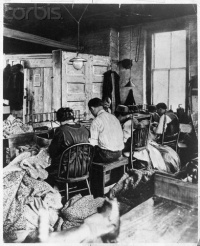From The Peopling of New York City
Income
The garment industry, in which a majority of Jewish immigrants participated in, was notorious for the exploitation of its workers. Garment workers had to work anywhere between eight and eighteen hours a day to be able to earn a living. The mass influx of European immigrants during the late 19th century affected the wages of the garment industry. The large number of immigrants that became available to work after they immigrated to New York drastically drove wages down. Immigrants were criticized for accepting the low wages that employers offered and causing a decrease in wages for other workers. In reality, immigrant workers had no choice but to accept whatever wages were available to them in order to be able to make a living for themselves and their families.
In 1882, after the large influx of immigrant workers, weekly wages dropped to $8 to $9 a week. Around this time, women garment workers earned about $3.81 to $4.50. [1]
Women’s low wages were probably due to the fact that they were restricted to the less skilled, lower paid areas of the industry. These wages, however, were not always consistent. It was hard to calculate average wages because of two major reasons. The first was the seasonal employment as some workers were not able to work year round and at times went long periods without income. The second reason was the fact that some immigrants worked under organized unions while some did not. Because of this, it was not uncommon to see, coat makers for example, make as much as $15 a week to $1 a week. Samplemakers could also earn anything between “$3 to $50 weekly”.[1] However, it was more common for immigrants to have wages on the lower end of the range.
References
- ↑ 1.0 1.1 1.2 Kosak, Hadassa. Cultures of Opposition Jewish Immigrant Workers, New York City, 1881-1905 (Suny Series in American Labor History). New York: State University of New York P, 2000.

